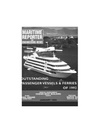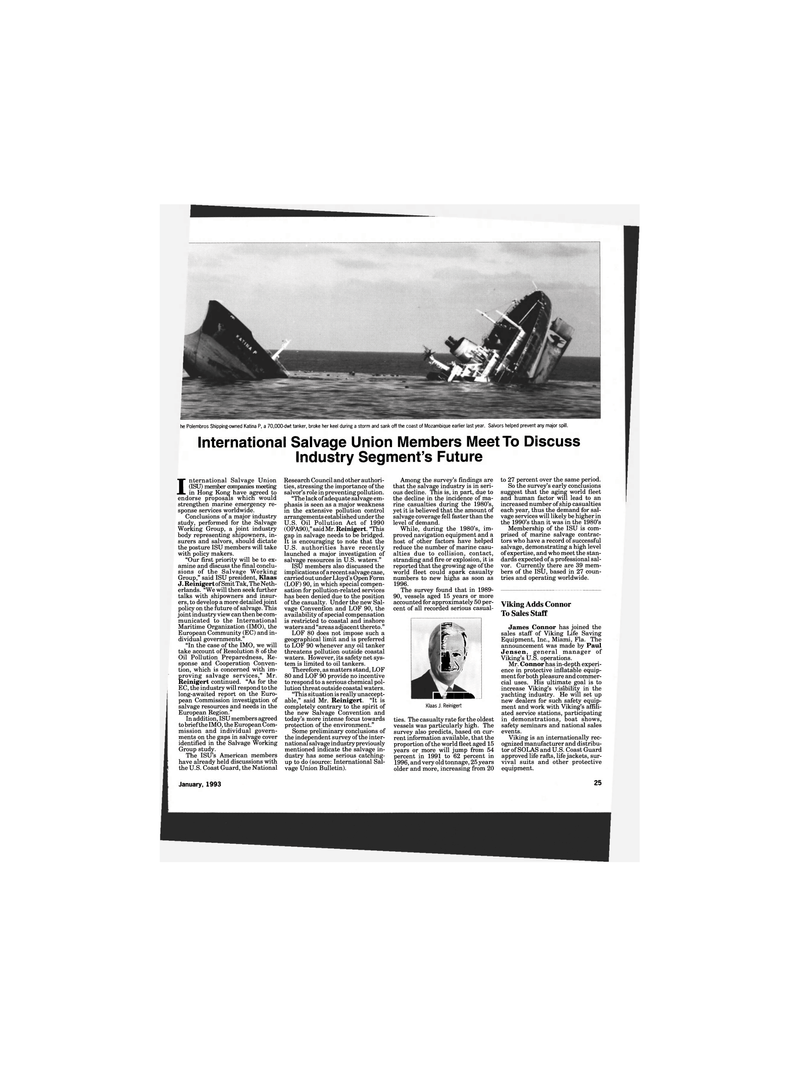
Page 23: of Maritime Reporter Magazine (January 1993)
Read this page in Pdf, Flash or Html5 edition of January 1993 Maritime Reporter Magazine
he Polembros Shipping-owned Katina P, a 70,000-dwt tanker, broke her keel during a storm and sank off the coast of Mozambique earlier last year. Salvors helped prevent any major spill.
International Salvage Union Members Meet To Discuss
Industry Segment's Future
International Salvage Union (ISU) member companies meeting in Hong Kong have agreed to endorse proposals which would strengthen marine emergency re- sponse services worldwide.
Conclusions of a major industry study, performed for the Salvage
Working Group, a joint industry body representing shipowners, in- surers and salvors, should dictate the posture ISU members will take with policy makers. "Our first priority will be to ex- amine and discuss the final conclu- sions of the Salvage Working
Group," said ISU president, Klaas
J. Reinigert of Smit Tak, The Neth- erlands. "We will then seek further talks with shipowners and insur- ers, to develop a more detailed joint policy on the future of salvage. This j oint industry view can then be com- municated to the International
Maritime Organization (IMO), the
European Community (EC) and in- dividual governments." "In the case of the IMO, we will take account of Resolution 8 of the
Oil Pollution Preparedness, Re- sponse and Cooperation Conven- tion, which is concerned with im- proving salvage services," Mr.
Reinigert continued. "As for the
EC, the industry will respond to the long-awaited report on the Euro- pean Commission investigation of salvage resources and needs in the
European Region."
In addition, ISU members agreed to brief the IMO, the European Com- mission and individual govern- ments on the gaps in salvage cover identified in the Salvage Working
Group study.
The ISU's American members have already held discussions with the U.S. Coast Guard, the National
Research Council and other authori- ties, stressing the importance of the salvor's role in preventing pollution. "The lack of adequate salvage em- phasis is seen as a major weakness in the extensive pollution control arrangements established under the
U.S. Oil Pollution Act of 1990 (OPA90)," said Mr. Reinigert. "This gap in salvage needs to be bridged.
It is encouraging to note that the
U.S. authorities have recently launched a major investigation of salvage resources in U.S. waters."
ISU members also discussed the implications of a recent salvage case, carried out under Lloyd's Open Form (LOF) 90, in which special compen- sation for pollution-related services has been denied due to the position of the casualty. Under the new Sal- vage Convention and LOF 90, the availability of special compensation is restricted to coastal and inshore waters and "areas adjacent thereto."
LOF 80 does not impose such a geographical limit and is preferred to LOF 90 whenever any oil tanker threatens pollution outside coastal waters. However, its safety net sys- tem is limited to oil tankers.
Therefore, as matters stand, LOF 80 and LOF 90 provide no incentive to respond to a serious chemical pol- lution threat outside coastal waters. "This situation is really unaccept- able," said Mr. Reinigert. "It is completely contrary to the spirit of the new Salvage Convention and today's more intense focus towards protection of the environment."
Some preliminary conclusions of the independent survey of the inter- national salvage industry previously mentioned indicate the salvage in- dustry has some serious catching- up to do (source: International Sal- vage Union Bulletin).
Among the survey's findings are that the salvage industry is in seri- ous decline. This is, in part, due to the decline in the incidence of ma- rine casualties during the 1980's, yet it is believed that the amount of salvage coverage fell faster than the level of demand.
While, during the 1980's, im- proved navigation equipment and a host of other factors have helped reduce the number of marine casu- alties due to collision, contact, stranding and fire or explosion, it is reported that the growing age of the world fleet could spark casualty numbers to new highs as soon as 1996.
The survey found that in 1989- 90, vessels aged 15 years or more accounted for approximately 50 per- cent of all recorded serious casual- fl 2J ^ \<
Hf
AoH lib.
Klaas J. Reinigert ties. The casualty rate for the oldest vessels was particularly high. The survey also predicts, based on cur- rent information available, that the proportion of the world fleet aged 15 years or more will jump from 54 percent in 1991 to 62 percent in 1996, and very old tonnage, 25 years older and more, increasing from 20 to 27 percent over the same period.
So the survey's early conclusions suggest that the aging world fleet and human factor will lead to an increased number of ship casualties each year, thus the demand for sal- vage services will likely be higher in the 1990's than it was in the 1980's
Membership of the ISU is com- prised of marine salvage contrac- tors who have a record of successful salvage, demonstrating a high level of expertise, and who meet the stan- dards expected of a professional sal- vor. Currently there are 39 mem- bers of the ISU, based in 27 coun- tries and operating worldwide.
Viking Adds Connor
To Sales Staff
James Connor has joined the sales staff of Viking Life Saving
Equipment, Inc., Miami, Fla. The announcement was made by Paul
Jensen, general manager of
Viking's U.S. operations.
Mr. Connor has in-depth experi- ence in protective inflatable equip- ment for both pleasure and commer- cial uses. His ultimate goal is to increase Viking's visibility in the yachting industry. He will set up new dealers for such safety equip- ment and work with Viking's affili- ated service stations, participating in demonstrations, boat shows, safety seminars and national sales events.
Viking is an internationally rec- ognized manufacturer and distribu- tor of SOLAS and U.S. Coast Guard approved life rafts, life jackets, sur- vival suits and other protective equipment.
January, 1993 25

 22
22

 24
24
